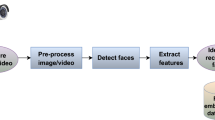Abstract
With technological innovations soaring high researchers are able to develop more efficient and adaptable biometric recognition systems. Biometric systems work by matching different biometric traits to templates in a database. Recognition systems use soft as well as hard biometrics. Soft biometrics are facial or birth marks, gender, race etc. whereas hard biometrics include fingerprint, iris, retina, face etc. In this paper we have proposed a methodology by clubbing an existing facial recognition system with the statistics attained from facial marks in order to mend the recognition rate between before after surgically altered images of human beings. Firstly an algorithm is introduced for spontaneously identifying facial marks, which are represented using Histograms of Oriented Gradients (HOG), secondly they are accorded to their location in the face image. The proposed methodology is implemented on the plastic surgical facial dataset. Widespread experiments are lead in order to show the efficacy of the anticipated facial mark detection process, and to substantiate the benefits of using the statistics of facial marks on top of customary face acknowledgement schemes. The above mentioned methodology is till date not implemented on surgically altered facial image samples.


Similar content being viewed by others
References
Ricanek K (2013) The Next Biometric Challenge: Medical Alterations. Computer 46:94–96
Park U, Jain AK (2010) Face matching and retrieval using soft biometrics. IEEE Trans Inf Forensics Secur 5:406–415
Park U, Liao S, Klare B, Voss J, Jain AK (2011) Face finder: filtering a large database using scars, marks and tattoos. MSU Technical Report, MSU-CSE-11-15
Singh R, Vatsa M, Bhatt HS (2010) Plastic surgery: a new dimension to face recognition. IEEE Trans Inf Forensics Sec 5(3):441–448
Park U, Jillela RR, Ross A, Jain AK (2011) Periocular biometrics in the visible spectrum. IEEE Trans Inf Forensics Sec 6(1):96–106
Ross A, Jain A (2003) Information fusion in biometrics. Pattern Recognit Lett 24:2115–2125
Ahonen T, Hadid A, Pietikainen M (2006) Face description with local binary patterns: application to face recognition. IEEE Trans Pattern Anal Mach Intell 28(12):2037–2041
Bay H, Ess A, Tuytelaars T, Van Gool L (2008) Surf: speeded up robust features. Comput Vis Image Underst 110(3):346–359
Bellhumer PN, Hespanha J, Kriegman D (1997) Eigenfaces vs. fisherfaces: Recognition using class specific linear projection. IEEE Trans Pattern Anal Mach Intell 17(7):711–720
Liu X, Shan S, Chen X (2013) Face recognition after plastic surgery: a comprehensive study. In: Lee KM, Matsushita Y, Rehg JM, Hu Z (eds) Computer vision – ACCV 2012. ACCV 2012. Lecture notes in computer science, vol 7725. Springer, Berlin. https://doi.org/10.1007/978-3-642-37444-9_44
Verghis TJ, Uma S, Bhuvaneshwari P (2014) A multi-objective evolutionary approach to face matching across plastic surgery. COMPUSOFT Int J Adv Comput Technol 3(2):529–532
Lakshmiprabha NS, Bhattacharya J, Majumder S (2011) Face recognition using multimodal biometric features. In: 2011 international conference on image information processing, Shimla, 2011, pp 1–6. https://doi.org/10.1109/ICIIP.2011.6108945
Mun M, Deorankar A (2014) Implementation of plastic surgery face recognition using multimodal biometric features. IJCSIT Int J Comput Sci Inf Technol 5(3):3711–3715
De Marsico M, Nappi M, Riccio D, Wechsler H (2015) Robust face recognition after plastic surgery using region-based approaches. Pattern Recogn 48(4):1261–1276. https://doi.org/10.1016/j.patcog.2014.10.004
Bhatt HS, Bharadwaj S, Singh R, Vatsa M (2013) Recognizing surgically altered face images using multi-objective evolutionary algorithm. IEEE Trans Inf Forensics Secur 8(1):89–100
Nappi M, Rictiardi S, Tistarelli M (2016) Deceiving faces: when plastic surgery challenges face recognition. Image Vis Comput 54:71–82
Sabharwal T, Gupta R, Son LH, Kumar R, Jha S (2019) Recognition of surgically altered face images: an empirical analysis on recent advances. Artif Intell Rev 52(2):1009–1040
Sabharwal T, Gupta R (2019) Human identification after plastic surgery using region based score level fusion of local facial features. J Inf Secur Appl 48:102373. https://doi.org/10.1016/j.jisa.2019.102373
Plastic surgery face database, http://iiitd.edu.in/iab/Image_Analysis_and_Biometrics_Group/Resources.html, http://iabrubric.org/resources.html, http://www.plasticsurgery.org/aboutasps.html. Accessed 16 Oct 2018
American Society of Plastic Surgeons (ASPS) website: http://www.plasticsurgery.org/about-asps.html. Accessed 16 Oct 2018
Aggarwal G, Biswas S, Flynn PJ (2012) A sparse representation approach to face matching across plastic surgery. IEEE Workshop Appl Comput Vis (WACV) 2012:113–119
Ahmed El-said S, Atta HMA (2014) Geometrical face recognition after plastic surgery. Int J Comput Appl Technol 49(3/4):352–364. https://doi.org/10.1504/IJCAT.2014.062371
Ali ASO, Sagayan V, Malik A, Aziz A (2016) Proposed face recognition system after plastic surgery. IET Comput Vis 10(5):342–348
Ahmed AS (2018) Comparative study among sobel, prewitt and canny edge detection operators used in image processing. J Theor Appl Inf Technol 96:6517–6525
Mehta H (2009) On innovations in plastic surgery. J Plastic Reconstr Aesthet Surg 62:437–441
Becerra-Riera F, Morales-González A, Vazquez H (2017) Facial marks for improving face recognition. Pattern Recogn Lett. https://doi.org/10.1016/j.patrec.2017.05.005
Author information
Authors and Affiliations
Corresponding author
Rights and permissions
About this article
Cite this article
Sabharwal, T., Gupta, R. Facial marks for enhancing facial recognition after plastic surgery. Int. j. inf. tecnol. 13, 391–396 (2021). https://doi.org/10.1007/s41870-020-00566-x
Received:
Accepted:
Published:
Issue Date:
DOI: https://doi.org/10.1007/s41870-020-00566-x



